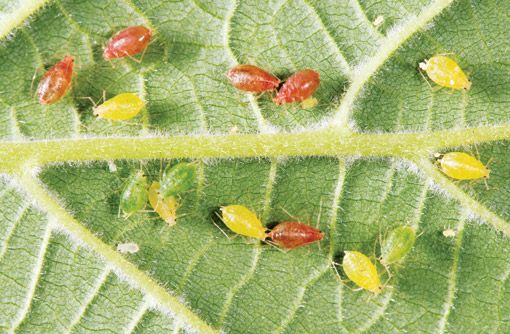Research project aims to enhance aphid prediction

A weekly aphid alert service has helped growers minimise preventative insecticide use during the past season, believes one researcher.
“Our weekly updated Aphid Advisory Alert service forecasting aphid numbers and their likely arrival date, accurately predicted a late fly-in and low numbers of peach-potato aphids,” says Richard Harrington of Rothamsted Research.
“It was one of the latest in half a century, in fact, leaving only very late-sown crops vulnerable.”
However, crops are at risk for reasons other than aphid migration, he warns. Resistance is gradually limiting the armoury growers rely on to control the numerous aphid species carrying damaging viruses, including turnip yellows virus (TuYV) and barley yellow dwarf virus (BYDV).
“Our monitoring for pest activity also highlights the level of insecticide resistance found in aphids in the suction traps across the country. We regularly find resistance to pyrethroids in the grain aphid and to pirimicarb and pyrethroids in the peach-potato aphid.”
The appearance in the 1990s of MACE resistance, a mechanism that peach-potato aphids use to overcome pirimicarb, is being mirrored now in southern Europe against neonicotinoids.
That poses a significant future threat to aphid control in the UK, warns Steve Foster of Rothamsted Research. And pyrethroids are not reliable as an alternative to neonicotinoids.
He co-ordinates a project which collects and tests peach-potato aphids from field and protected crops with a range of current and novel insecticides, to highlight shifts in sensitivity in the insect population.
By anticipating the problems with peach-potato aphids and grain aphids through a separate HGCA/Potato Council-funded project, he can advise on control decisions.
“We need to know how widespread resistance is and whether new resistance mechanisms are appearing in the field to further reduce aphicide activity. It’s particularly important with treatments coming and going due to political pressure, as in the recent case of the restriction on neonicotinoid seed treatments from December in crops attractive to bees,” explains Dr Foster.
The European Commission’s decision affects all oilseed crops, maize, and any cereal crop sown between January and June. But with peach-potato aphids and cabbage stem flea beetle at large, the neonicotinoid restriction is likely to impact most on oilseed rape production, warns Caroline Nicholls, HGCA research and knowledge transfer manager.
About 60% of the total crop area is affected by TuYV, with average yield loss estimated at 15%. Without insecticides, the calculated annual loss to TuYV is 206,010 t, costing the industry approximately £67m a year, she says.
“All the alternatives to neonicotinoids for autumn use against the peach-potato aphid have resistance issues of their own, so an increase in the incidence of TuYV is likely. We must support work to find solutions and guidance for growers.”
Further research will help to rationalise the use of insecticides, save money on inputs, reduce harm to aphid natural enemies and lower the risk of insecticide resistance developing, she concludes.
If you have problems controlling peach-potato aphids and suspect resistance to insecticides other than pyrethroids and pirimicarb, contact stephen.foster@rothamsted.ac.uk
Summary
Project 3768: Combating resistance to aphicides in UK aphid pests; From April 2012 to 2015. £24,000.
Project 3475: Aphid Advisory Alerts; From April 2009 to 2014. £173,945.
Project 0004: Population genetic analysis of pyrethroid resistant grain aphids; From July 2013 to 2014. £10,892.
Partners include ADAS, Bayer CropScience, Belchim Crop Protection, BBRO, Chemicals Regulation Directorate, Dewar Crop Protection, DuPont, HDC, Interfarm, NuFarm, Potato Council, Rothamsted Research and Syngenta.
Plus Research Review 77: Implications of the restriction on the neonicotinoids, imidacloprid, clothianidin and thiamethoxam, on crop protection in oilseeds and cereals in the UK.
HGCA perspective
• Aphids transmit viruses which cause significant yield losses
• Closely monitoring pest abundance and resistance
• Testing existing and new aphicides to guide decision-making on treatments
Interim report available on HGCA website
Crops perspective
Growers are being kept well informed, with projects alerting them to likely pest infestations, resistance issues and the implications of insecticide restrictions. This research should be continued to ensure effective control of aphids as new threats arise.
Barley yellow dwarf virus levels set to rise
Catch up with previous Research in Focus articles

